I guess it’s true what they say about product marketing—it suffers from an identity crisis.
Because product marketing is closely related to some other roles in marketing, it’s not that obvious what product marketing is really about. That being said, once you learn what product marketers do, it’s impossible to imagine launching a successful product without them.
So let’s jump in and demystify product marketing. In this article, you’ll learn the following:
Product marketing is the process of bringing a product to the market and communicating its value both externally to the market and internally within the organization.
This includes everything from market research to product positioning to creating effective marketing initiatives focused on increasing a product’s adoption in the marketplace.
Straight away, I’d like to address one popular misconception about product marketing. Some of you may have seen a graphical explanation of product marketing.
The explanation is in the form of a Venn diagram, showing how this discipline shares some commonalities with product and sales departments. Well, this is not entirely accurate.
You see, product marketing is essentially a subdivision of marketing. It’s not as interdisciplinary as the Venn diagram depicts it to be. It’s not sales + product + marketing = product marketing.
Doing product marketing is basically doing marketing that’s focused on everything directly related to making a product successful in the market. And that responsibility has been a part of marketing since the conception of the four Ps of marketing (product, price, place, and promotion).
So as we go further and learn what kinds of activities constitute product marketing, let’s try to remember this:
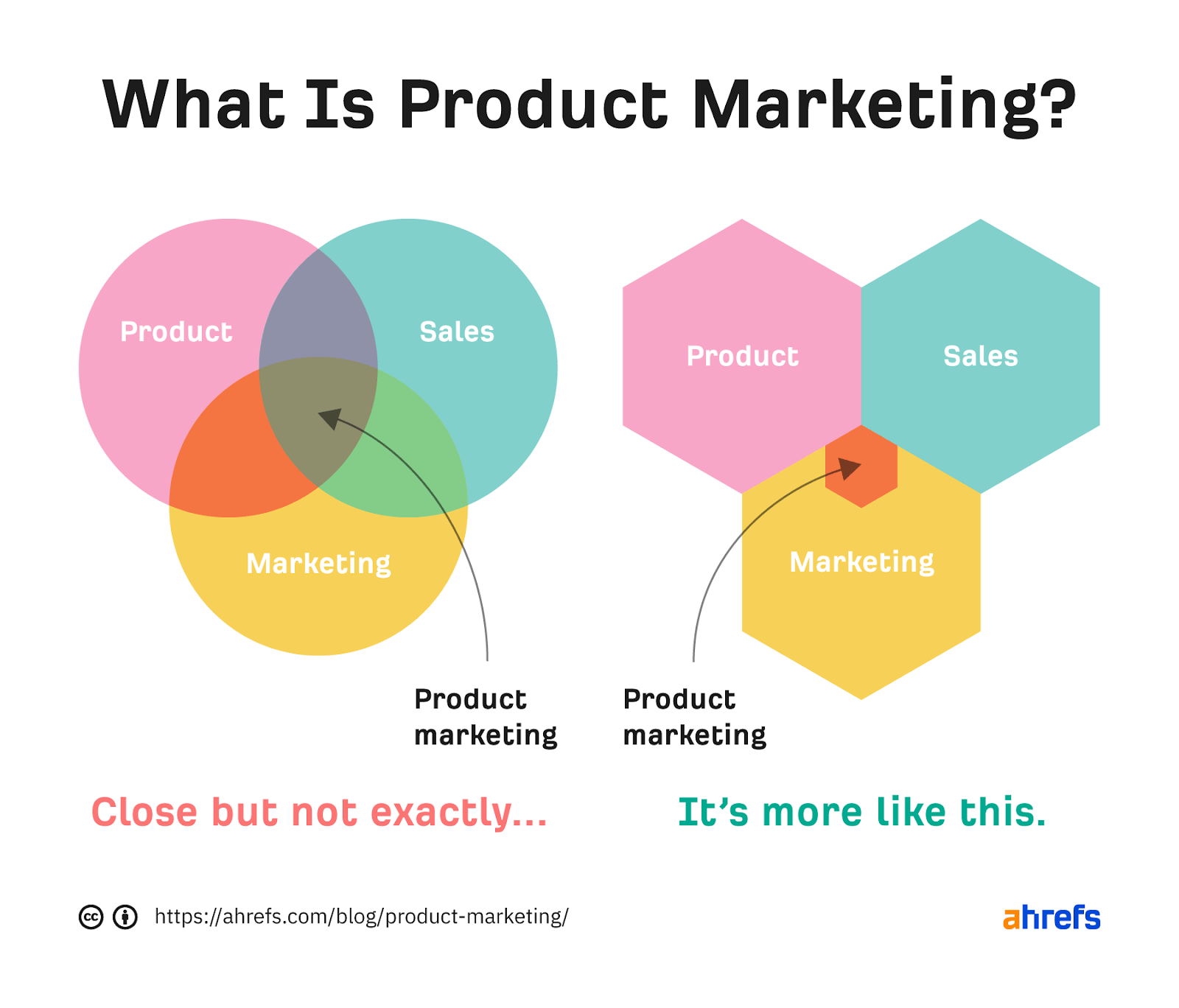
The answer is quite simple: You can’t create and launch a successful product without product marketing. You can’t do that without knowing what to build and who to market the product to.
Moreover, if you want to stand any chance of success in the market, you need to know how to efficiently position and communicate your product’s value to create demand among your target audience.
All the things mentioned above relate to product marketing. So if you were to become a product marketer, become a product marketing manager, or hire one, what would the role entail? Let’s answer that too.
Here are some key areas of a product marketer’s role:
| What | Why |
|---|---|
| Market research | Among others: ‑Understanding customers’ needs and wants ‑Identifying opportunities in the market ‑Understanding the competition |
| Go-to-market strategy | Identifying what will be offered, to what market, at what price, how it will be offered, and what is required operationally to launch the product |
| Creating a positioning and messaging plan | -Determining the benefits that the product should be identified with ‑Determining how to catch the attention of the target audience and educate them about the product |
| Product communication (external and internal) | -Externally: creating demand for the product by communicating its features and benefits ‑Internally: product education and making sure external communication is consistent |
| Marketing collateral | Creating the collection of media used to support the sales of the product (e.g., sales brochures, knowledge base articles, data sheets, demos) |
| Gathering user feedback | -Understanding how satisfied users are with the product ‑Suggesting improvements in the product and how it’s delivered to the market |
| Product analytics | Understanding how users engage with the product, e.g., feature usage, points of friction, user retention |
| New feature launches | Delivering new features to the market and driving their adoption |
It’s also worth knowing that a product marketer doesn’t need to do all of those things. Those tasks can be divided in such a way that different product marketers within an organization will specialize in a subset of those activities.
On the other hand, at Ahrefs, much of what our marketing department does is product marketing. Yet only a handful of team members are engaged with the product enough to be known as “product marketers.”
To make things a bit clearer, this is what we (a company with over 70 people) expect from a product marketer:
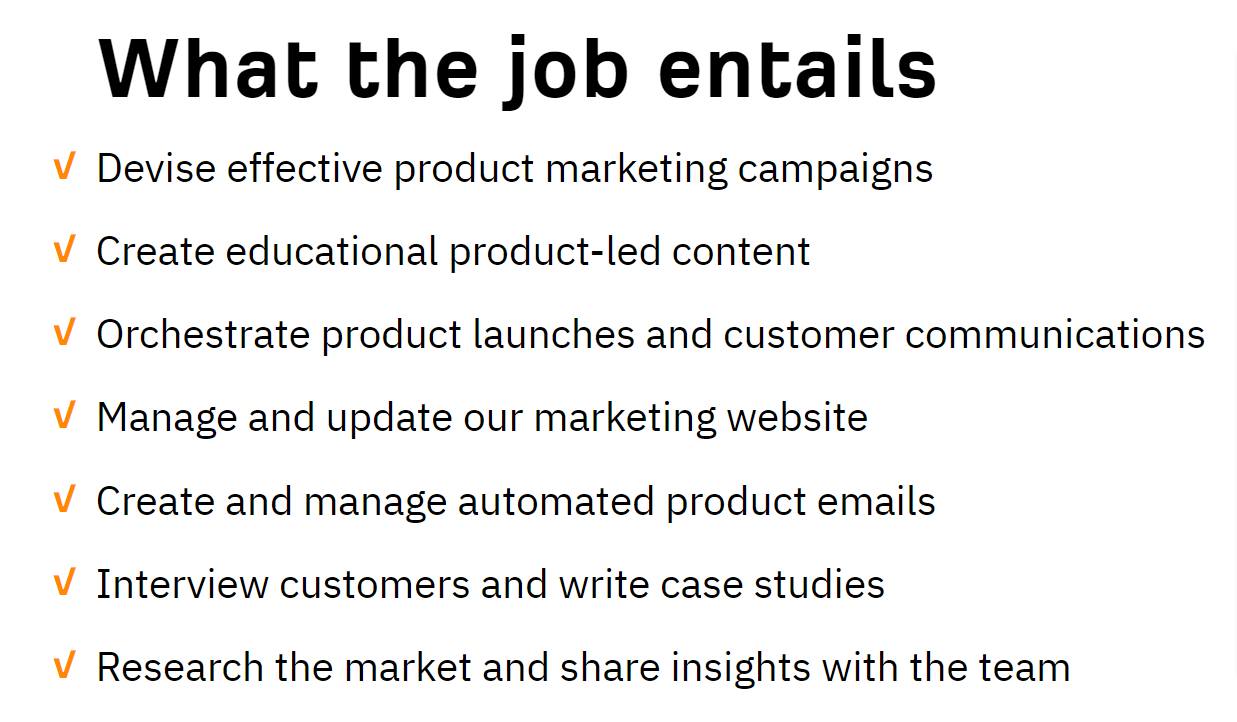
Some things on that list are not exclusive to a product marketer in our marketing team. For example, most of us are involved in creating product-led content. However, a specific “mix” of those duties makes it a good fit for a product marketer specialization.
Here are some main steps product marketers usually take to bring products to the market and communicate them. Let’s describe the steps chronologically: before the product launch and after the product launch.
Pre-launch
This stage can be summed up with one concept: go-to-market strategy (GTM strategy). A GTM strategy is basically a company’s plan to introduce a new product or service to the market. Typically, product marketers own these strategies.
When you look at the steps within the GTM, you will see a few familiar activities listed in the table above. However, in a properly executed GTM strategy, these activities need to be arranged in order and supplemented with a few more points.
So here are the eight steps in the GTM process, along with the vital questions they help to answer:
- Identify your market (along with your competitors) – This is the product’s “environment” for growth. What opportunities are there? Who will you be playing “against”?
- Identify your customer – Who are you trying to sell to? How will your product make people’s lives better?
- Define product positioning and price – How should your product be perceived by the target audience? Are you offering more benefits for a lower price or maybe more benefits for a higher price?
- Define product messaging and core marketing tactics – What do you say to potential customers to sell your product? What marketing channels can you use to reach them?
- Define product distribution – How will a user access your product? Directly or maybe through distributors?
- Sync marketing, sales, and support – What do sales, support, and other marketing team members need from you to make this product a success? And what do you need from them?
- Determine the budget, time frame, and resources needed – Time, resources, and money: How much will the product launch consume?
- Define your success metrics – How will you know you have achieved product-market fit? How will you measure growth?
If you’d like to read more on the topic of GTM strategies, head over to this guide.
Post-launch
In other words, this stage includes everything that needs to be taken care of after you launch the product:
We just launched Ahrefs Webmaster Tools!https://t.co/WESA9JZDM7
We want ALL content creators to have the data they need to improve their websites – so we’re making some parts of Ahrefs FREE for everyone. Think of it as us picking up where GSC left off 😉
Please help to RT!
— Ahrefs (@ahrefs) September 22, 2020
Namely, after the product launch, product marketers will be involved in the following activities. (Note that they are ongoing activities and not necessarily performed in this order.)
- Internal and external product communication – A product marketer’s goal is twofold here: demand generation and product adoption. The first is about attracting visitors to the product; the latter is about helping users use product features to accomplish their goals.
- Product analytics – Product marketers don’t need to guess how users engage with the product. They can track this with analytics software (e.g., Mixpanel, Heap).
- Gathering user feedback – This is how product marketers can perform the important role of being the customer’s advocate. Knowing which remarks to prioritize and which to ignore is an art in itself. But it can lead to dramatic improvements within the product.
- Feature launches – Product marketers devise communication and coordinate feature launches using various marketing channels.
That’s about it when it comes to basic theory on product marketing and a product marketer’s role. Let’s see some examples of how all these can be put into practice.
We’ve said it many times before, and we’ll say it again: The single best advice we can give on product marketing (or marketing in general) is to invest in your product.
Make your product so good that people will be willing to recommend it to others. Make sure you have achieved product-market fit and never stop improving product satisfaction. It will make your job as a marketer a lot easier. Otherwise, don’t be surprised that none of your marketing efforts work.
The examples of product marketing tactics listed below have worked for us only because we’ve made sure Ahrefs lives up to its promise.
1. Blogging with product-led content
Here is a simple chart that perfectly illustrates our philosophy of doing content marketing:
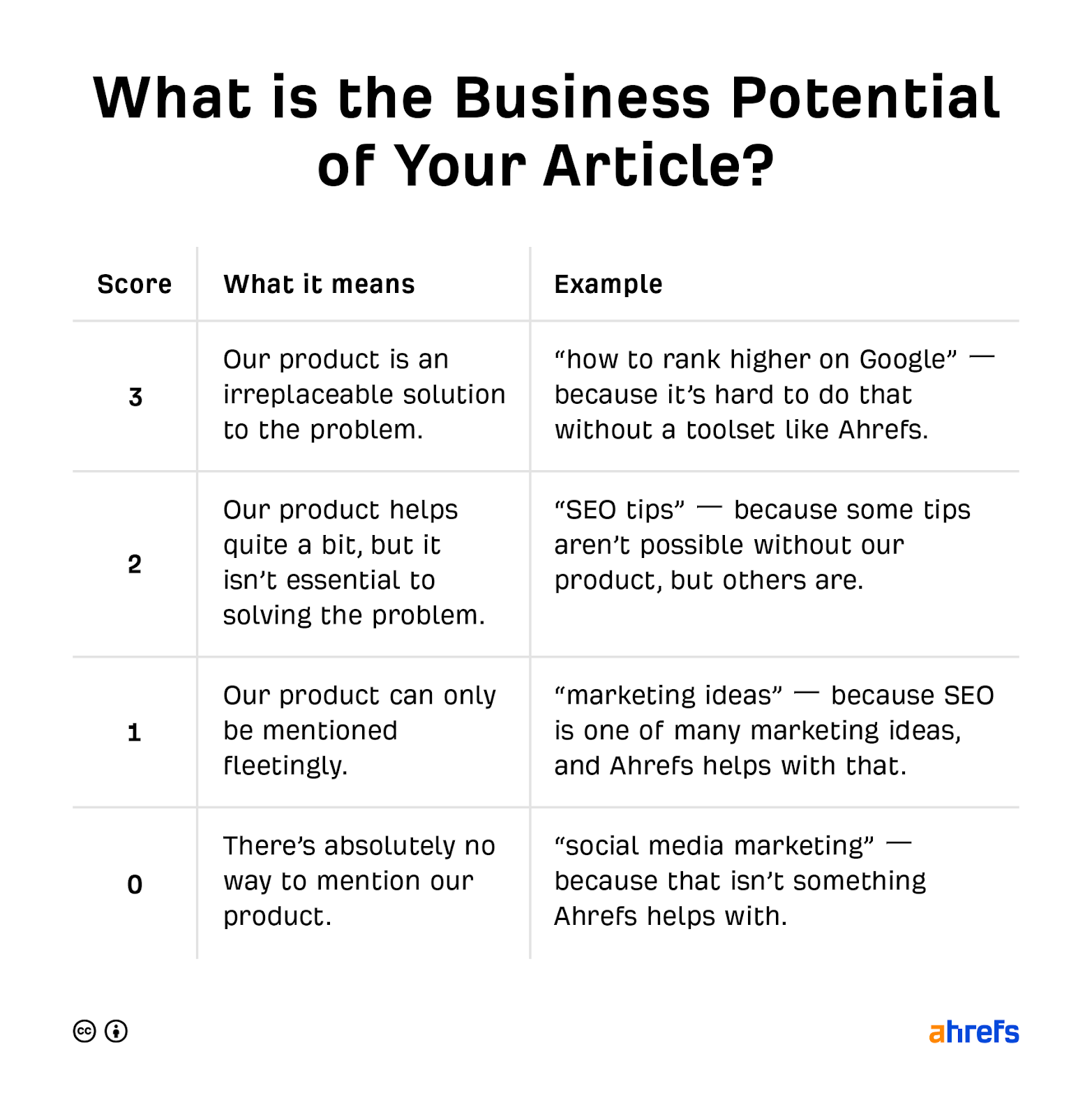
It’s called creating product-led content, and it works like this: prioritize topics that score at least “1” on the business potential (BP) scale. In other words, the BP scale expresses our ability to illustrate the features and benefits of Ahrefs (our product).
In case you don’t know, Ahrefs is an all-in-one SEO toolset that helps marketers rank higher on search engines and get more traffic—even if they’re just starting out with SEO.
So as you can probably tell from our blog, we focus on SEO-related topics and more general marketing topics where we can showcase our product or explain how we approach a solution to a given marketing problem.
So, in practice, we do keyword research to identify topics we want to cover. In this process, business potential helps us sift through thousands of ideas to find ones that can help us do product marketing effectively.
Here’s an example. To show how people can uncover organic keywords otherwise hidden in Google Analytics, we’ve featured Ahrefs Webmaster Tools as one of the solutions.

This way, people searching for the solution in search engines can find our article and, hence, our product. This kind of content drives both product demand and product adoption; it generates traffic to our website and shows people how to use the product.
We use the same tactic in video content creation. Here’s the same principle but in the context of a different topic and a different part of our product offer.
https://www.youtube.com/watch?v=taU9P98zfjk
2. Product feature launches
We’re constantly working on making our product better than before. This means launching new features and data updates regularly.
In this area of our product marketing, we try to make sure our announcements are as visible as they can be. In order to do that, we communicate the product through various channels:
- Product blog
- Social media
- Email newsletter
- Digital advertising
- Facebook Insider group (exclusive for our customers)
- PR (for bigger announcements)
- Inside the product (example below)

For example, with the new keyword data update, our users can rest assured they’re looking at the biggest U.S. keyword data in the industry. Knowing this will help them make more confident SEO decisions. This information is great, and we added it in a big banner that is hard to overlook.
As we communicate with our target audience through so many channels using tailored messaging, we also need to coordinate tasks appropriately with multiple team members. And so each product update becomes more or less a product marketing campaign on its own.
Naturally, launching new features requires some internal communication too. We have a Slack channel for each newly introduced feature or update. This way, we keep everybody informed and provide a place to discuss new releases.
3. Community engagement
Some products gather a community around them. When that happens, brands need to take part in the conversation—whether through a community manager, product marketer, social media manager, or some other role—because that’s also an area of product marketing.
The goal here can be driving product demand:
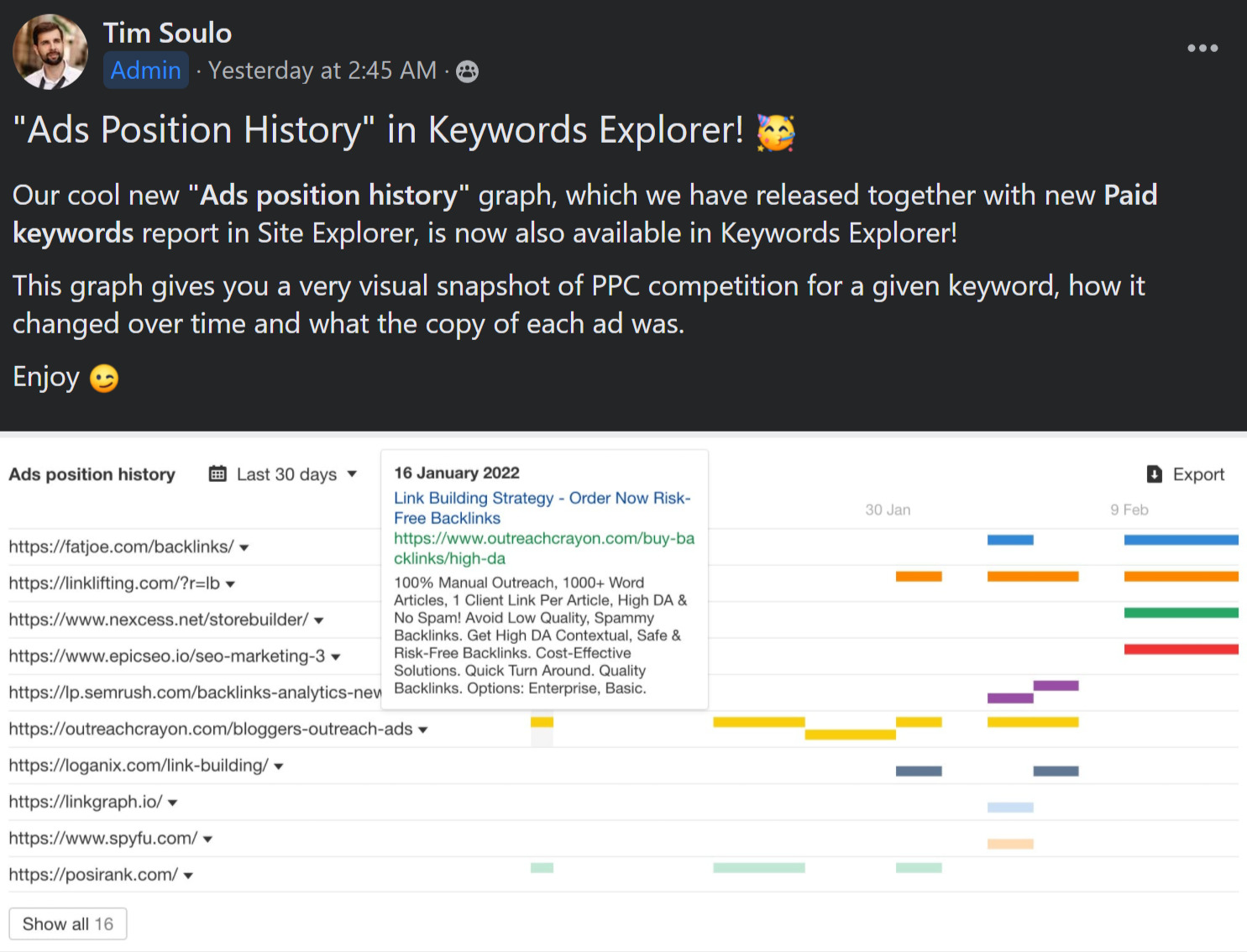
Or driving product adoption:

Or just answering a question:
Pretty simple methodology. For every keyword in the database we see a page ranking for, we take the search volume and estimated CTR data to calculate the traffic coming from that term. It typically undercounts because we may not have some really long tail or unpopular terms.
— Patrick Stox (@patrickstox) January 6, 2022
All these are examples of product marketing done within a community. Communities like these are often self-sustaining but shouldn’t be left alone.
Product marketing’s role in this scope is to make sure the community gets accurate information and is aware of new developments relating to the product.
As a “by-product” of that, people get better at using the product. Hence, they’ll likely use it more and will be more likely to recommend it to others.
4. User onboarding
User onboarding (aka product onboarding) is a stage within the product adoption process. It’s when a user is actively introduced to the features of the product. It’s an important stage of the process.
This is because the messaging that made the user sign up for the product won’t be enough to make them know how to use the product. And only users who know how to use the product (but not necessarily all of its features) can become satisfied customers.
User onboarding typically refers to the first steps users take “inside” the product—a sort of “showing the user around.”
For product adoption to be successful, users need to understand the value of the product as soon as possible.
So the goal of the product marketer is to get users to the so-called “aha-moment” quickly and smoothly.
A tried and tested technique of user onboarding is to send automated email workflows, which are triggered immediately after the user signs up for the product.
There are different “styles” of doing this. We try to keep it short with only three messages and include the most important information inside the first.

An excerpt from our “welcome” email.
This email above shows the user that we’ve got their back and have prepared more than enough educational materials to show them how they can become successful, thanks to our product.
Since our product can be quite intimidating to newcomers, we also include contextual help in the form of tooltips. These tooltips explain how to use the different reports and the meanings of the metrics inside them.

5. Product education
Beyond user onboarding, we have “regular” product education and support. For us, it’s a stage where product adoption blends with generating demand because nearly all of our content is product-led content.
This means the same materials used for user education in one channel can be, at the same time, the materials that drive visitors to us through organic search.
For example, a paying customer looks for a step-by-step tutorial on how to build links to their site and finds this article on our blog. But another person, who is not our customer, accesses the same article through a search engine like Google.
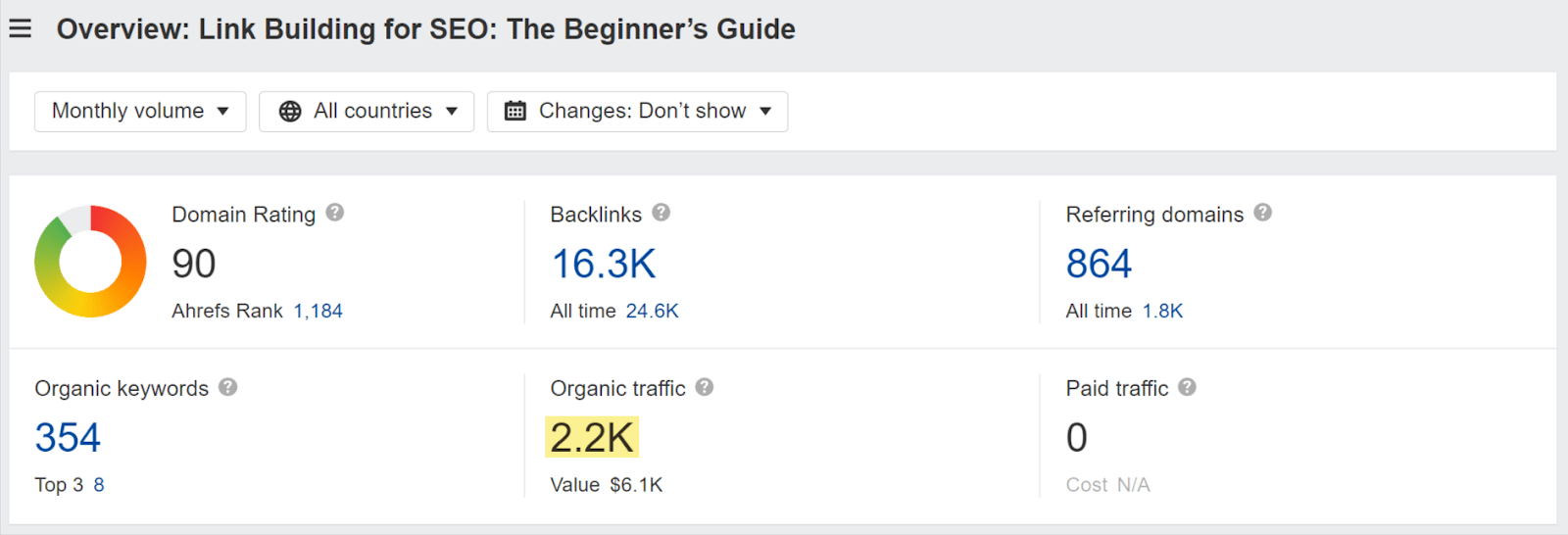
Our guide to link building for SEO drives an estimated 2.2K organic visits per month. Data via Ahrefs’ Site Explorer.
This brings us to our knowledge base, another outcome of product marketing. Knowledge bases are so popular that they don’t need a special introduction. A knowledge base is a place where we aim to maximize product adoption as other companies do.
On a side note, it’s likely no product-led content marketing can substitute the good ol’ knowledge base.
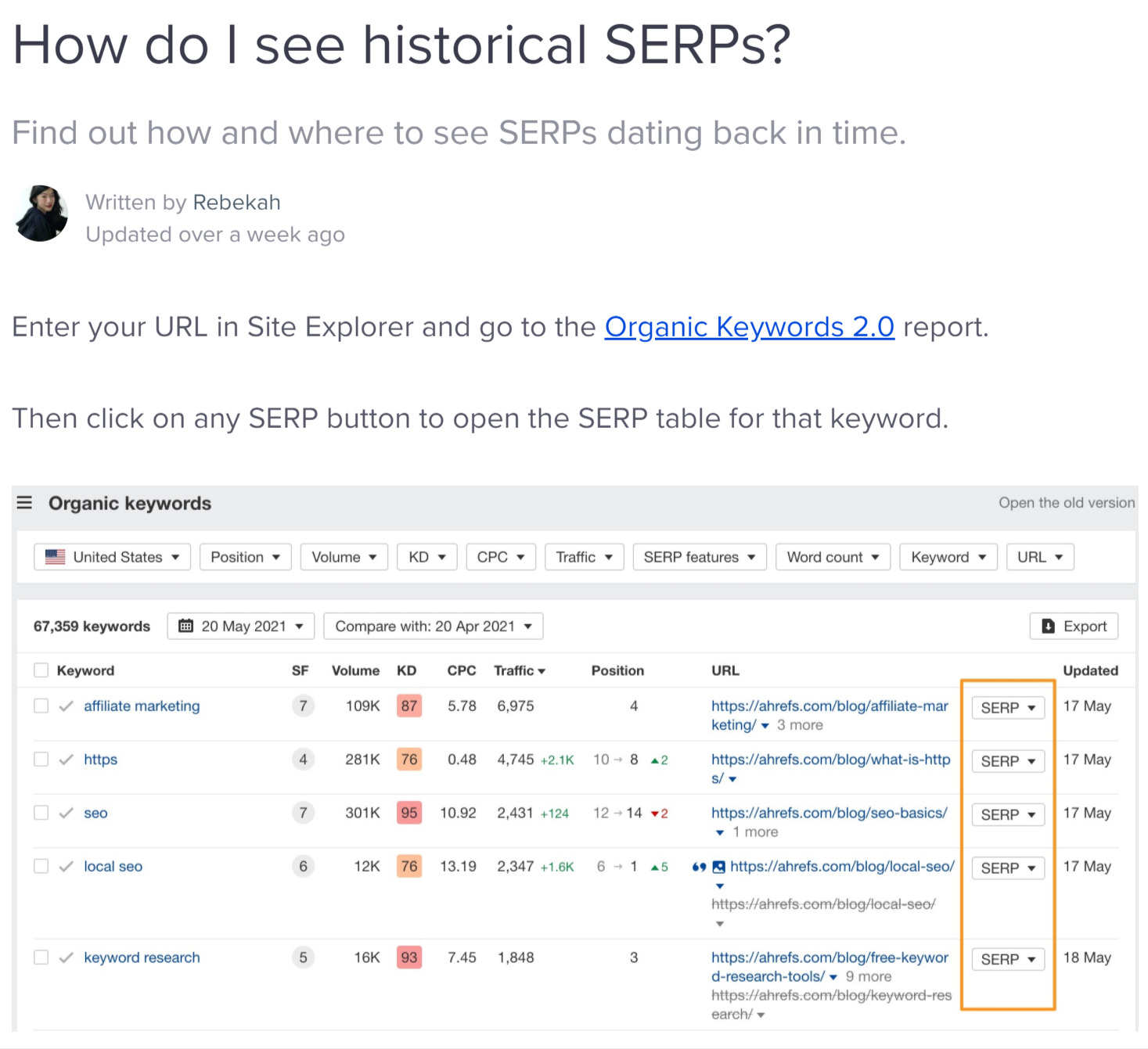
Did someone say historical SERPs in Ahrefs? Sure, here’s how.
That said, product education for a set of tools like Ahrefs requires something more than letting users discover educational content through search. It needs an organized curriculum. This is why we built the Ahrefs Academy. It’s packed with helpful video tutorials and is completely free of charge.

One of the courses from the Ahrefs Academy. Everybody can learn how to use Ahrefs in a step-by-step, self-paced course.
6. Gathering user feedback
No matter how visionary your product is, user feedback is the key to building superior products. In fact, there is a popular notion that you should ship your product fast (even if it’s not perfect) just to learn if you’ve got a product that shows enough potential (see value hypothesis).
At Ahrefs, we gather feedback on our product in three ways:
- An always-on customer feedback management platform
- Agile, bite-sized surveys
- Interviews with customers (sporadically)
Let’s take a quick look at the first two methods.
For the first method, we use Canny. It’s an open platform that lets users share their ideas on improving Ahrefs, comment on those ideas, and vote on them. So not only can we learn about others’ ideas, but we can also know how many people share those views.

For the second method, we usually ask our community at Ahrefs Insider. Unlike Canny, this is a group (currently on Facebook) available to only paying users. We get important feedback through that channel, and we do listen to it:
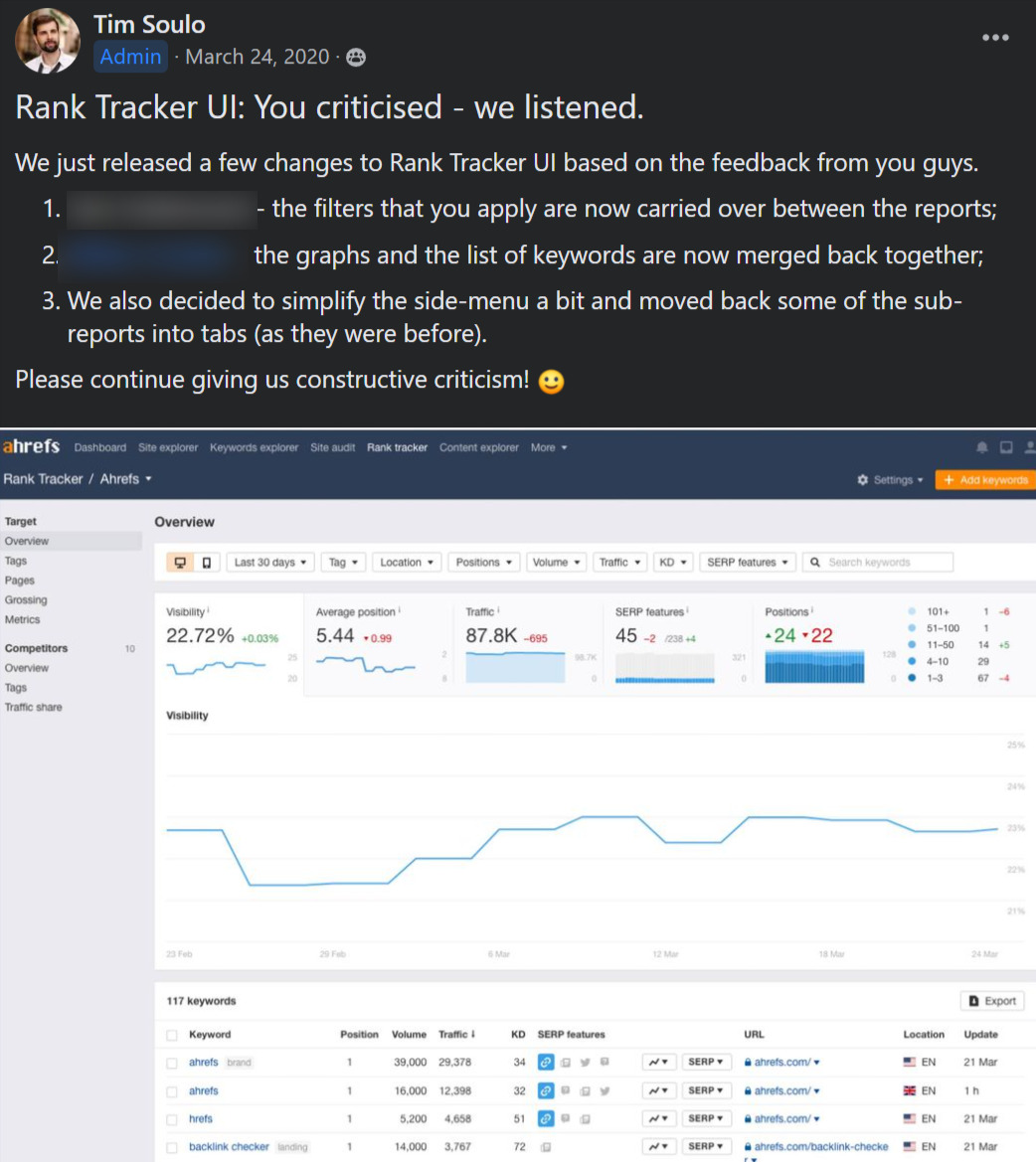
On top of that, every two years (on the same day), we ask this question openly on Reddit:
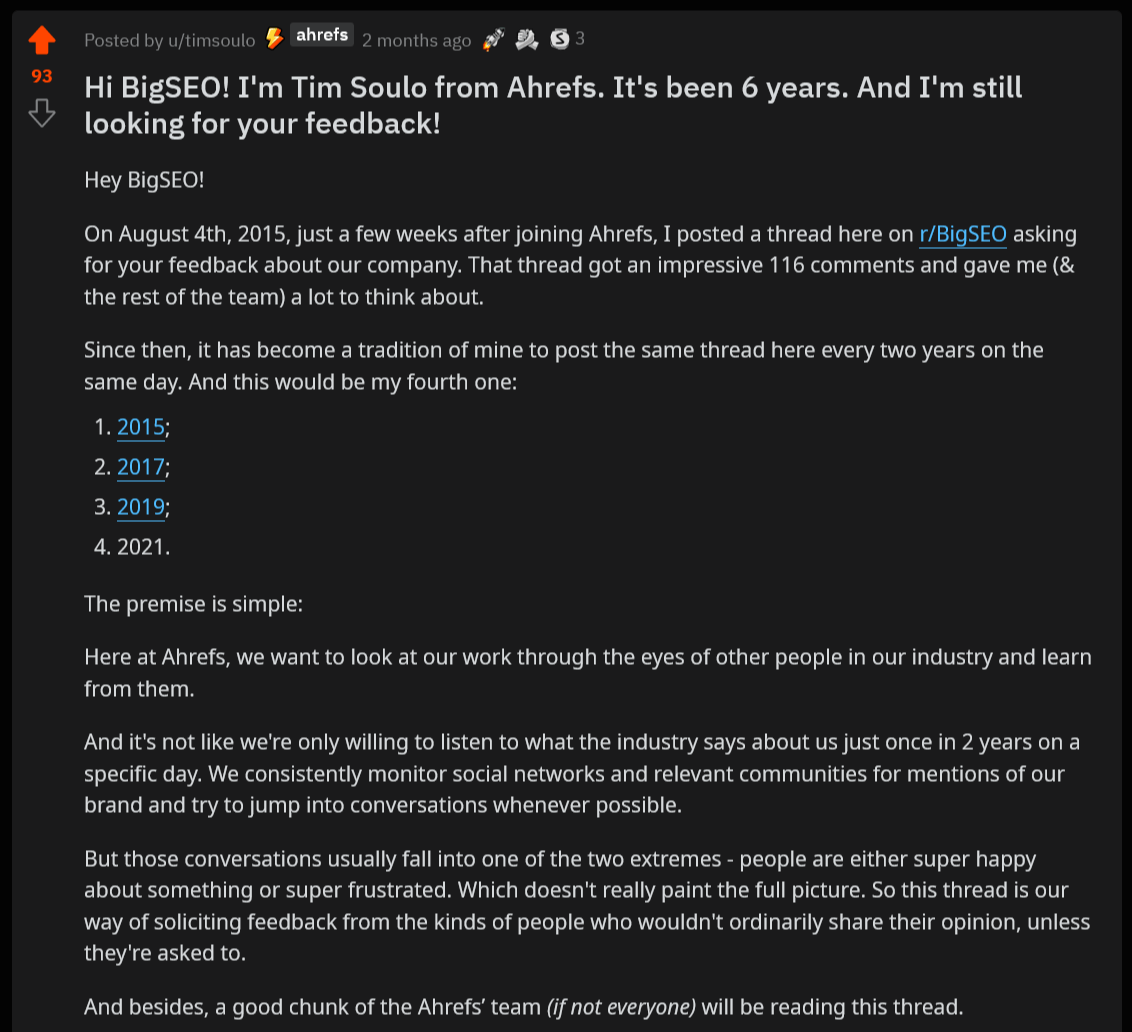
7. Homepage design
Last but not least, let’s look at Ahrefs’ product messaging on the homepage. Creating a homepage that shapes brand and product communication is an art and science. It’s supposed to educate, entertain, and convert at the same time. And it’s also a part of a product marketer’s job.
Let me give the floor to Ahrefs CMO Tim Soulo, who made a video to explain how we created Ahrefs’ current homepage. Among other things, you’re going to learn:
- Why we expanded our communication to the “problem-aware” audience.
- How we decided to explain Ahrefs to newcomers.
- Why extending the customer journey on purpose is sometimes a good idea.
https://www.youtube.com/watch?v=B_GE_Hkx40U
Final thoughts
Honestly, it’s quite odd that product marketing creates so much confusion. After all, marketing a product can’t be done without product marketing. It even sounds quite self-explanatory. If you’re doing a good job at marketing, you’re probably also doing a good job at product marketing.
I have a feeling that some 30 years ago, product marketing would be called just “marketing.” It’s just that in recent years this set of marketing activities has been extracted from a bigger set and given an identity of its own. And it’s no wonder. Marketing has been burgeoning with specializations for years.
Does every marketing team need a product marketer? Sooner or later, probably yes. But does every marketing team need product marketing? Definitely.
Got questions or comments? Ping me on Twitter.
